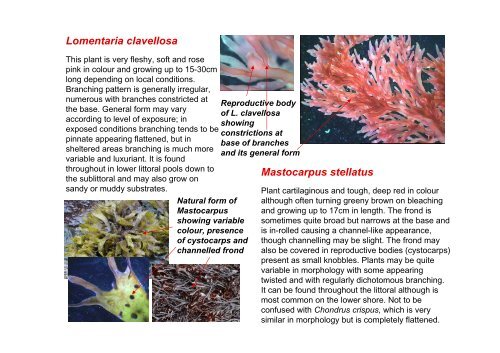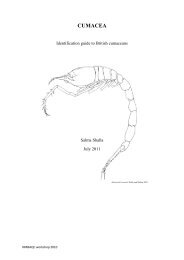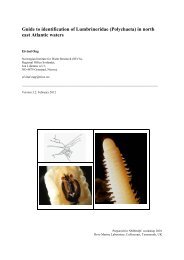s A Field Guide to the British Seaweeds - NMBAQC
s A Field Guide to the British Seaweeds - NMBAQC
s A Field Guide to the British Seaweeds - NMBAQC
Create successful ePaper yourself
Turn your PDF publications into a flip-book with our unique Google optimized e-Paper software.
Lomentaria clavellosa<br />
This plant is very fleshy, soft and rose<br />
pink in colour and growing up <strong>to</strong> 15-30cm<br />
long depending on local conditions.<br />
Branching pattern is generally irregular,<br />
numerous with branches constricted at<br />
<strong>the</strong> base. General form may vary<br />
according <strong>to</strong> level of exposure; in<br />
exposed conditions branching tends <strong>to</strong> be<br />
pinnate appearing flattened, but in<br />
sheltered areas branching is much more<br />
variable and luxuriant. It is found<br />
throughout in lower lit<strong>to</strong>ral pools down <strong>to</strong><br />
<strong>the</strong> sublit<strong>to</strong>ral and may also grow on<br />
sandy or muddy substrates.<br />
Natural form of<br />
Mas<strong>to</strong>carpus<br />
showing variable<br />
colour, presence<br />
of cys<strong>to</strong>carps and<br />
channelled frond<br />
Reproductive body<br />
of L. clavellosa<br />
showing<br />
constrictions at<br />
base of branches<br />
and its general form<br />
Mas<strong>to</strong>carpus stellatus<br />
Plant cartilaginous and <strong>to</strong>ugh, deep red in colour<br />
although often turning greeny brown on bleaching<br />
and growing up <strong>to</strong> 17cm in length. The frond is<br />
sometimes quite broad but narrows at <strong>the</strong> base and<br />
is in-rolled causing a channel-like appearance,<br />
though channelling may be slight. The frond may<br />
also be covered in reproductive bodies (cys<strong>to</strong>carps)<br />
present as small knobbles. Plants may be quite<br />
variable in morphology with some appearing<br />
twisted and with regularly dicho<strong>to</strong>mous branching.<br />
It can be found throughout <strong>the</strong> lit<strong>to</strong>ral although is<br />
most common on <strong>the</strong> lower shore. Not <strong>to</strong> be<br />
confused with Chondrus crispus, which is very<br />
similar in morphology but is completely flattened.




